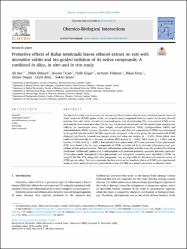| dc.contributor.author | Şen, Ali | |
| dc.contributor.author | Özbeyli, Dilek | |
| dc.contributor.author | Teralı, Kerem | |
| dc.contributor.author | Göger, Fatih | |
| dc.contributor.author | Yıldırım, Aybeniz | |
| dc.contributor.author | Ertaş, Büşra | |
| dc.contributor.author | Doğan, Ahmet | |
| dc.contributor.author | Bitiş, Leyla | |
| dc.contributor.author | Şener, Göksel | |
| dc.date.accessioned | 2023-05-10T07:16:36Z | |
| dc.date.available | 2023-05-10T07:16:36Z | |
| dc.date.issued | 2022 | en_US |
| dc.identifier.citation | Şen, A., Özbeyli, D., Teralı, K., Göger, F., Yıldırım, A., Ertaş, B., ... & Şener, G. (2023). Protective effects of Rubus tereticaulis leaves ethanol extract on rats with ulcerative colitis and bio-guided isolation of its active compounds: A combined in silico, in vitro and in vivo study. Chemico-Biological Interactions, 369, 110263. | en_US |
| dc.identifier.issn | 1872-7786 | |
| dc.identifier.uri | https://dx.doi.org/10.1016/j.cbi.2022.110263. | |
| dc.identifier.uri | https://hdl.handle.net/20.500.12933/1518 | |
| dc.description.abstract | The aim of this study was to evaluate the therapeutic effect of active ethanol extract obtained from the leaves of Rubus tereticaulis (RTME) against colitis, and to purify major compounds from this extract by bioassay-directed isolation. Rats with colitis induced via intra-rectal acetic acid administration (5%, v/v) received RTME or sulfasalazine for three consecutive days. On day four, all rats were decapitated, and the colonic tissue samples were collected for macroscopic score, colon weight, reduced glutathione (GSH), myeloperoxidase (MPO), and malondialdehyde (MDA) analyses. The active compounds and chemical composition of RTME were determined by bio-guided isolation and LC-MS/MS, respectively. Compared to the colitis group, the rats treated with RTME displayed significantly lowered macroscopic scores and colon wet weights (p < 0.001). These effects were confirmed biochemically by a decrease in colonic MPO activity (p < 0.001), MDA levels (p < 0.001), and an increase in GSH levels (p < 0.001). Kaempferol-3-O-β-d-glucuronide (RT1) and quercetin-3-O-β-d-glucuronide (RT2) were found to be the major compounds of RTME, as evidenced by in vitro anti-inflammatory and antioxidant activity-guided isolation. Their anti-inflammatory/antioxidant activities were also predicted by docking simulations. Additionally, quinic acid, 5-caffeoylquinic acid, quercetin pentoside, quercetin glucoside, quercetin-3-O-β-d-glucuronide, kaempferol-3-O-β-d-glucuronide, and kaempferol rutinoside were identified in RTME via using LC-MS/MS. RT2, along with other compounds, may be responsible for the observed protective action of RTME against colitis. This study represents the first report on the beneficial effects of RTME in an experimental model of colitis and highlights the potential future use of RTME as a natural alternative to alleviate colitis. | en_US |
| dc.language.iso | en | |
| dc.publisher | Elsevier | en_US |
| dc.relation.ispartof | Chemico-biological interactions | |
| dc.rights | info:eu-repo/semantics/embargoedAccess | en_US |
| dc.subject | Anti-Inflammatory Activity | en_US |
| dc.subject | Antioxidant Activity | en_US |
| dc.subject | Colitis | en_US |
| dc.subject | Flavonoids | en_US |
| dc.subject | Rubus Tereticaulis | en_US |
| dc.title | Protective effects of Rubus tereticaulis leaves ethanol extract on rats with ulcerative colitis and bio-guided isolation of its active compounds: A combined in silico, in vitro and in vivo study | en_US |
| dc.type | Article | |
| dc.identifier.orcid | 0000-0002-9665-0256 | en_US |
| dc.department | AFSÜ | en_US |
| dc.institutionauthor | Göger, Fatih | |
| dc.identifier.doi | 10.1016/j.cbi.2022.110263 | |
| dc.identifier.volume | 369 | en_US |
| dc.relation.publicationcategory | Makale - Ulusal Hakemli Dergi - Kurum Öğretim Elemanı | en_US |
| dc.identifier.pmid | 36375516 | |
| dc.identifier.scopus | 2-s2.0-85142319014 | |
| dc.identifier.scopusquality | Q1 | |
| dc.identifier.wos | WOS:000967045500001 | |
| dc.identifier.wosquality | Q1 | |
| dc.indekslendigikaynak | Web of Science | |
| dc.indekslendigikaynak | Scopus | |
| dc.indekslendigikaynak | PubMed | |
















